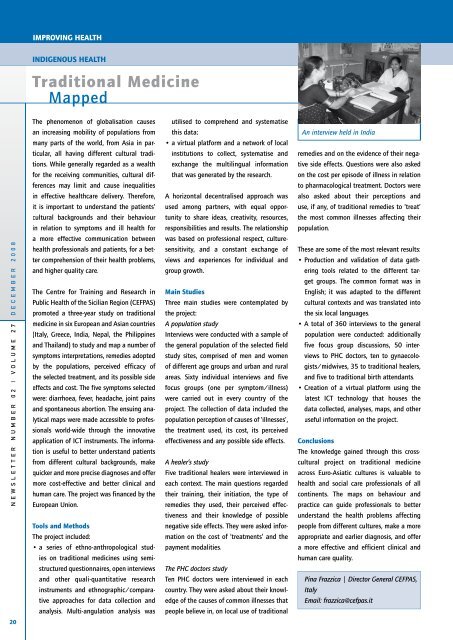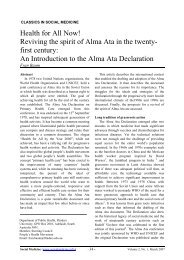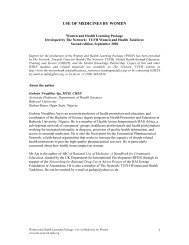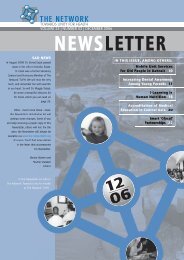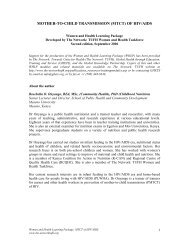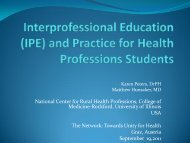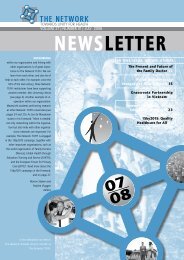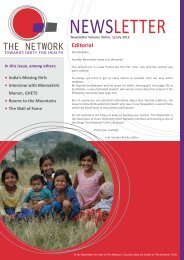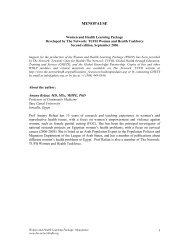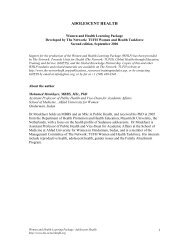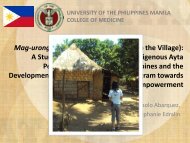The network - Towards Unity For Health
The network - Towards Unity For Health
The network - Towards Unity For Health
You also want an ePaper? Increase the reach of your titles
YUMPU automatically turns print PDFs into web optimized ePapers that Google loves.
IMPROVING HEALTHINDIGENOUS HEALTHTraditional MedicineMapped<strong>The</strong> phenomenon of globalisation causesutilised to comprehend and systematisean increasing mobility of populations fromthis data;An interview held in Indiamany parts of the world, from Asia in par-• a virtual platform and a <strong>network</strong> of localticular, all having different cultural tradi-institutions to collect, systematise andremedies and on the evidence of their nega-tions. While generally regarded as a wealthexchange the multilingual informationtive side effects. Questions were also askedfor the receiving communities, cultural dif-that was generated by the research.on the cost per episode of illness in relationferences may limit and cause inequalitiesto pharmacological treatment. Doctors werein effective healthcare delivery. <strong>The</strong>refore,A horizontal decentralised approach wasalso asked about their perceptions andit is important to understand the patients’used among partners, with equal oppor-use, if any, of traditional remedies to ‘treat’cultural backgrounds and their behaviourtunity to share ideas, creativity, resources,the most common illnesses affecting theirin relation to symptoms and ill health forresponsibilities and results. <strong>The</strong> relationshippopulation.a more effective communication betweenwas based on professional respect, culture-D E C E M B E R 2 0 0 8health professionals and patients, for a bettercomprehension of their health problems,and higher quality care.<strong>The</strong> Centre for Training and Research inPublic <strong>Health</strong> of the Sicilian Region (CEFPAS)promoted a three-year study on traditionalsensitivity, and a constant exchange ofviews and experiences for individual andgroup growth.Main StudiesThree main studies were contemplated bythe project:<strong>The</strong>se are some of the most relevant results:• Production and validation of data gatheringtools related to the different targetgroups. <strong>The</strong> common format was inEnglish; it was adapted to the differentcultural contexts and was translated intothe six local languages.N E W S L E T T E R N U M B E R 0 2 | V O L U M E 2 7medicine in six European and Asian countries(Italy, Greece, India, Nepal, the Philippinesand Thailand) to study and map a number ofsymptoms interpretations, remedies adoptedby the populations, perceived efficacy ofthe selected treatment, and its possible sideeffects and cost. <strong>The</strong> five symptoms selectedwere: diarrhoea, fever, headache, joint painsand spontaneous abortion. <strong>The</strong> ensuing analyticalmaps were made accessible to professionalsworld-wide through the innovativeapplication of ICT instruments. <strong>The</strong> informationis useful to better understand patientsfrom different cultural backgrounds, makequicker and more precise diagnoses and offermore cost-effective and better clinical andhuman care. <strong>The</strong> project was financed by theEuropean Union.A population studyInterviews were conducted with a sample ofthe general population of the selected fieldstudy sites, comprised of men and womenof different age groups and urban and ruralareas. Sixty individual interviews and fivefocus groups (one per symptom/illness)were carried out in every country of theproject. <strong>The</strong> collection of data included thepopulation perception of causes of ‘illnesses’,the treatment used, its cost, its perceivedeffectiveness and any possible side effects.A healer’s studyFive traditional healers were interviewed ineach context. <strong>The</strong> main questions regardedtheir training, their initiation, the type ofremedies they used, their perceived effec-• A total of 360 interviews to the generalpopulation were conducted: additionallyfive focus group discussions, 50 interviewsto PHC doctors, ten to gynaecologists/midwives,35 to traditional healers,and five to traditional birth attendants.• Creation of a virtual platform using thelatest ICT technology that houses thedata collected, analyses, maps, and otheruseful information on the project.Conclusions<strong>The</strong> knowledge gained through this crossculturalproject on traditional medicineacross Euro-Asiatic cultures is valuable tohealth and social care professionals of allcontinents. <strong>The</strong> maps on behaviour andpractice can guide professionals to bettertiveness and their knowledge of possibleunderstand the health problems affectingTools and Methodsnegative side effects. <strong>The</strong>y were asked infor-people from different cultures, make a more<strong>The</strong> project included:mation on the cost of ‘treatments’ and theappropriate and earlier diagnosis, and offer• a series of ethno-anthropological stud-payment modalities.a more effective and efficient clinical andies on traditional medicines using semi-human care quality.structured questionnaires, open interviews<strong>The</strong> PHC doctors studyand other quali-quantitative researchTen PHC doctors were interviewed in eachPina Frazzica | Director General CEFPAS,instruments and ethnographic/compara-country. <strong>The</strong>y were asked about their knowl-Italytive approaches for data collection andedge of the causes of common illnesses thatEmail: frazzica@cefpas.itanalysis. Multi-angulation analysis waspeople believe in, on local use of traditional20


